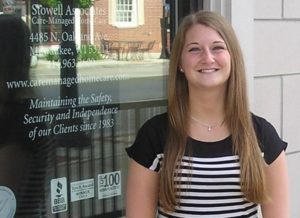
When considering whether one can age at home, the most important question to ask is “will it be safe?”
With more and more older adults choosing to stay in their homes or live with an adult child, many simple measures can be taken to make those environments safer.
At Stowell, we recommend a home safety assessment for new and established clients alike. When inspecting a home, a Care Manager will review over forty checkpoints, with a focus on decreasing the risk of falls and fire injury and making emergency access easier.
Fall Hazards
According to the Centers for Disease Control and Prevention (CDC), millions of people over 65 have falls each year, with one in five falls causing serious injury. While there are many risk factors that lead to falls, most falling hazards around the home can be easily remedied:
Replace worn or torn carpets.
Be sure smaller rugs have non-skid backing.
Remove unnecessary clutter that can make getting around more difficult.
Stairs should be in good condition and clutter-free, with non-skid strips or carpeting. All railings should be secure.
Lighting
Poor lighting also increases the risk of falls.
Make sure that stairways and halls have adequate lighting, including nightlights. Add more lights if necessary.
Replace any burned out bulbs to ensure lights will be working when needed.
Think about where in the house someone might be walking at night. Is there enough light between the bed and the bathroom?
Bathroom
With the presence of water in a bathroom comes other fall risks.
If the tub or shower is slippery, add a non-skid mat or strips in the standing area.
If the older adult has trouble balancing, consider adding a shower chair.
Install grab bars on the walls by the bathtub and toilet to aid with stability.
By reducing the distance that a person has to move when they sit down, raised toilet seats can be helpful for people with mobility limitations, pain, reduced strength, or balance
Fire Safety
A 2015 study by the United States Fire Administration shows that older adults, while representing 15 percent of the United States population, suffered 40 percent of all fire deaths.
Be sure that smoke alarms and carbon monoxide detectors are present and working on each floor.
Space heaters should be at least 3 feet away from any objects that can burn.
Have an escape plan that takes the older adult’s abilities into account. If a wheelchair or cane is needed, make sure they can be accessed quickly. Keep glasses or hearing aids next to the bed.
Access and Information
In the event of an emergency, will family members or first responders be able to easily get into the house? Will they be able to find key medical information?
Set up a lockbox or hidden key to allow quick access to the house.
Be sure all vital documents are up-to-date and easily accessible, this includes:
Medical history and diagnoses
Medication list
Emergency contacts
Health care providers
Pharmacy
A copy of insurance/Medicare/Medicaid cards
Advanced directives
Home safety – and the changes needed to make one’s home safe – can be a difficult subject to discuss for some older parents. If you need help with a safety inspection, preparing vital documents, or facilitating a crucial conversation with a loved one, Stowell Care Managers are available to help.









